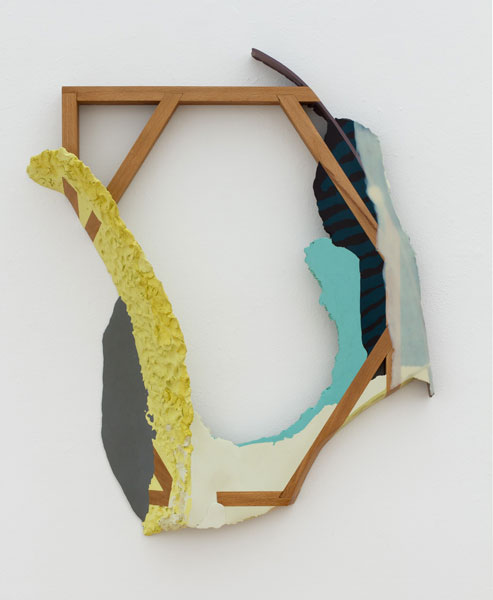
May 24, 2014

The support seems devoured in Christian Maychack’s “Compound Flat #41” (2014), epoxy clay, pigment and wood. Photo: Philip Maisel
Maychack’s objects teeter on the verge
Kenneth Baker
Should we call the new work of Christian Maychack at Lind relief sculpture, constructed painting, shaped or disfigured abstraction?
The quandary signals Maychack’s re-enlivening of an issue persistent in modern Western art: our uneasy relationships with objects - as observers, consumers, fabricators. The issue came into focus a century ago, when Marcel Duchamp designated as his artworks certain items of mass manufacture, thereby calling into question the nature of art, of creative effort, of originality, function and acquisitiveness.
Maychack has found his own way to this sort of provocation, echoing Duchamp (1887-1968) less than 1960s makers of the “shaped canvas,” such as Frank Stella, whose paintings’ eccentric geometry made the arbitrariness of pictures’ rectangularity clearly felt.
Note one exception: Maychack’s “Compound Flat #36” seems to refer explicitly to Duchamp’s canonical enigma known as the “Large Glass” (1915-23).
Maychack has painstakingly embedded what look like canvas strainer bars in new pieces such as “Compound Flat #41” (2014). Here he has shaped pigmented epoxy clay around a wood armature, making it look like paint that has gone a long way toward devouring its support.
It is as if Maychack were exposing - not without humor - some self-cannibalizing impulse within the media or the present moment of pictorial art. Many of his pieces ironically celebrate the traditional affinity between pictures and windows.
Harold Rosenberg coined the phrase “the anxious object” to title a 1964 collection of critical essays, and Maychack’s new work merits the term’s revival. Rosenberg concerned himself with the imperiled condition of authentic contemporary art, as he understood it, faced with an audience whose taste could never mature, swamped by the bullying trivialities of mass culture. (What a mercy that he did not live to see social media in action.)
Maychack presents objects that seem caught on the verge of disappearing down rabbit holes of their own devising. They evoke the vanishing of both critical modernism and of the sort of audience and attention attuned to it.
The overt zaniness of some of Maychack’s inventions muffles unanticipated elegiac notes.